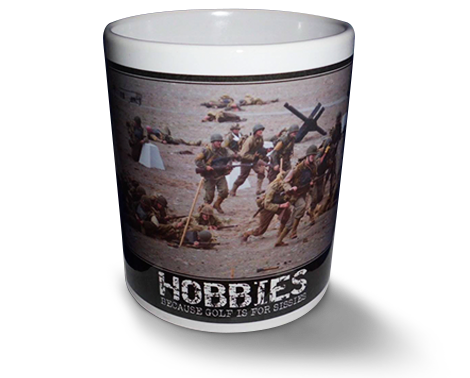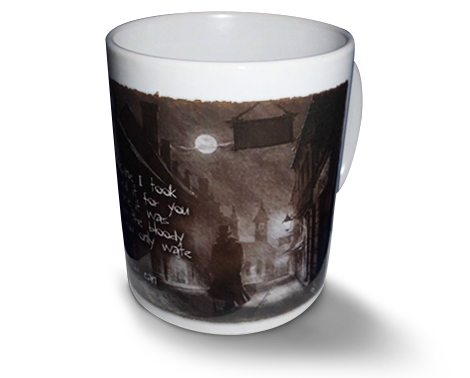Kurt Meyer Printed mug
11 oz Dishwasher and microwave proof printed mug!
SS-Brigadeführer and Waffen-SS General-Major Kurt Meyer
Born: December 23, 1910 in Jerxheim
Died: December 23, 1960 in Hagen, Westfalen
Iron Cross 2nd class: September 20, 1939
Iron Cross 1st class: June 8, 1940
German Cross in Gold: February 8, 1942
Knight's Cross May 18, 1941 SS-Sturmbannführer SS-Aufklärungs-Abteilung Leibstandarte SS Adolf Hitler in Greek battles.
Oak Leaves May 23, 1943 195th officer to receive this, SS-Panzer Aufklärungs Abteilung I, SS-Panzergrenadier Division, as LSSAH Commander in the Russian Campaign.
Swords August 27, 1944 91st officer to receive this, SS-Oberführer 12th SS-Panzer Division "Hitlerjugend" Commander, 1st SS-Panzer Corps, Heeresgruppe B (army group), Western Front.
Kurt Meyer is known from the history of the Second World War as the Panzermeyer joined the Leibstandarte in 1934 after working in Mecklenburg's Landespolizei. He participated in the police campaign, stood out with his unit on the Western Front near Rotterdam, near Dünkirchen, Saint Etienne's and Clermont-Farrand's surprise attacks, which gave him the nickname Fast Meyer.
Being in front of the LAH's motorized surveillance unit, he invaded successfully the South of Yugoslavia, crossed the Zarna River and took over the city of Bitola, which was already known from the World War I. He crossed the Javat Pass, went through the town of Florina and the village of Vevi. On April 12, 1941 the Leibstandarte managed to get the Klidi Pass but suffered great losses. Their aim from there on was towards Kastoria, where the Greek III Corps headquarters was situated. First they had to cross the Klisoura Pass which was 1,400 meters high. This seemed impossible and due to heading forward fast they had to leave heavy weaponry behind. The losses of the surveillance unit grew, the Greeks resistance was strong, the attack seemed to be on a halt, yet Kurt Meyer, who was then the SS-Sturmbannführer, forced his men to attack the Greeks again and again with his selfless actions. Thus he threw grenades towards his men on a mountainous road under the enemies fire to make his men walk forward. This kind of behavior was unusual, but considering the circumstances, it was successful. They managed to cross the channel despite all so they could see clearly the Greeks retreating and they continued to follow the enemies. Thanks to his actions in the Balkan battles, Meyer received a Knight's Cross.
In the fight with Russia, Meyer was a leader and a role model, he was tough with himself and with his men. His fast invasions during the LAH's operations, such as Rollbahn Nord, Kessel von Uman, Cherson, Perikop, Mariupul, Taganrog and Rostov, were a sign of masterful responsiveness and these are a part of the history of the Second World War. To reward him and his men, Meyer received a Knight's Cross with Oak Leaves.
When the selection of the 12th SS Panzer Division "Hitlerjugend" began in 1943, Meyer left his old unit to train young Hitlerjugend boys as a regiment Commander. He was supported by the Leibstandarte and Heer and Luftwaffe officers and younger officers with their war experiences. This young unit had to show itself at the beginning of the invasion on June 6, 1944, when the division was in the Caen area. Panzermeyer took over the division from the General Headquarters officer Hubert Meyer after the division's first Commander, SS-Brigadeführer Fritz Witt, died on June 16. Meyer cooperated with Heer's 2nd Panzer Division to protect the surrounding of Caen and kept it successfully from the enemies' attack. On June 26, 1944 he managed to avoid the Germans' right wing being surrounded by the strong British units. The opponents were the 49th and the 2nd British Tank Division, 31st Tank Brigade and the 15th Scottish Division.
Meyer held the position with poor equipment and under constant bombing with his division for two months. The units lost 60-70% of their battle force, companies were led by Unterführers, battalions were led by old Unterführers or young officers. Even their enemies admitted that the units showed excellent resistance, among those enemies was a Canadian, Chester Wilmot, from the 12th Panzer Division "Hitlerjugend" in his book "Fight for Europe".
The Canadian units sent some division members with cut pants back during the first attack, saying, "We don't fight with children." But this kind of attitude faded fast because the resistance of the 17-19 years old soldiers became stronger towards the enemies. On some front areas the Canadians didn't bother to take German prisoners to the camp but murdered them as soon as they were defeated. The British writer, Cornelius Ryan, who is known as an objectivist, has described these events in his book "The Longest Day: June 6, 1944 D-Day". The battles became more difficult and hopeless and on some occasions British and Canadian soldiers were killed after being captured. The "Hitlerjugend" Division managed to avoid a total "Normandie Staligrad" of the Caen-Falaise area thanks to its Commander's confident actions. The few survivors of this unit – not many division members were left after July and August – did not manage to break out of the closing bag nor save Heer's and the Waffen-SS units from being surrounded. SS-Oberführer Kurt Meyer received the Knight't Cross with Swords as the 91st soldier to acknowledge his and his men achievements, although most of his men were already dead or captured by the enemies.
On September 6, 1944 Meyer was captured by Belgium partisans who did not treat the captured Germans according to the Geneva Conventions. The next day he was given to the Americans after he was seriously wounded and needed medical help. In October, Meyer, as the 2nd (Heer's) Panzer Division Oberst, was taken "secretly" from Reims to England to the camp of war prisoners. After spending some months in a camp for especially "suspicious" Germans, he returned to Germany in the winter of 1945. He was then tried under the Canadian military court in Zurich/Friesiland for alleged war crimes. First he was sentenced to death but this decision was changed to lifelong imprisonment shortly after the process.
In 1951 Meyer was transferred from the Canadian prison to the war criminals camp in Werl/Westfalen. He was released on September 6.
During those six years the seriously wounded Panzermeyer had left, he was selflessly defending the survivors of his unit. He had negotiations with the representatives of the state, with the Chancellor of the Federal Republic of Germany, Dr Konrad Adenauer, and with the Social Democratic Party opposition ambassador Fritz Erler and with Erich Ollenhauer. The conviction of the Waffen-SS from Nürnberg in 1946 needed to be cancelled, the honor of the unit with almost 900,000 soldiers at the end of the war had to be restored. He set up an everlasting memorial for his soldiers in his book "Grenadiers". When Kurt Meyer died of cardiac insufficiency on his 50th birthday at his home in Hagen, he left behind a wife and five children: four girls and one boy. When he was buried on a gray and cold December day to a cemetery near Hagen-Delstern, thousands former Waffen-SS soldiers saluted him. A brave, exemplary and selfless modern Commander had left too early!
SS-Oberstgruppenführer (Colonel General) Josef
SS-Brigadeführer and Waffen-SS General-Major Kurt Meyer
SS-Obergruppenführer and Waffen-SS General Herbert Otto Gille
SS-Standartenführer Jochen Peiper
SS-Brigadeführer Wilhelm Mohnke
SS-Oberscharführer Sven Erik Olsson
SS-Brigadeführer Hugo Kraas
SS-Obersturmbannführer Max Wünsche
Hyazinth Graf Strachwitz von Gross-Zauche und Camminetz or Hyazinth von Strachwitz
SS-Gruppenführer and Waffen-SS General-Lieutenant Fritz von Scholz Edler von Rerancze
SS-Obergruppenführer and Waffen-SS General Felix Steiner
SS-Standartenführer (Colonel) Léon Degrelle
SS-Hauptsturmführer Hans-Gösta Pehrsson




